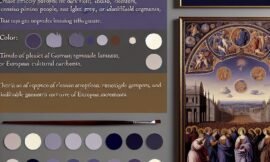Welcome to the fascinating world of watercolor pencils, where the precision of drawing meets the fluidity of painting. Whether you’re a traditional art collector or a digital art enthusiast, this versatile medium offers a unique range of possibilities. By harnessing the power of blending techniques and understanding the principles of creating depth, you can achieve stunning and vibrant artworks. In this comprehensive guide, we’ll delve into the intricacies of using watercolor pencils, explore trending art techniques, and provide insights that cater to artists of all levels.
Understanding Watercolor Pencils
The Basics of Watercolor Pencils
Watercolor pencils are a unique hybrid between colored pencils and watercolor paints. Encased in wood, they contain a water-soluble pigment that allows artists to blend dry colors with water, resulting in a watercolor effect. This makes them excellent for creating detailed line work as well as flowing washes of color.
Advantages of Using Watercolor Pencils
One of the main advantages of watercolor pencils is their versatility. Artists can use them dry to sketch or add water to achieve a softer, more painterly look. They are also portable, less messy than traditional watercolors, and perfect for outdoor painting or quick studies. This flexibility makes them appealing both to traditional artists and digital creators seeking inspiration from tactile mediums.

Getting Started with Watercolor Pencils
Essential Supplies You Need
To start with watercolor pencils, you’ll need a few essential supplies: a set of watercolor pencils, watercolor paper, a brush, and a container of water. The quality of these materials can vary, so investing in artist-grade supplies can improve your artwork’s vibrancy and longevity. Although synthetic brushes are usually cheaper, many artists prefer natural brushes for their ability to retain water.
Choosing the Right Surface
The type of paper you select can significantly affect the outcome of your work. Watercolor paper is highly recommended because it handles water application well without warping. It comes in three textures—hot-pressed (smooth), cold-pressed (slightly grainy), and rough. Experiment to find which texture best suits your style and the effect you desire.
Techniques for Using Watercolor Pencils
Basic Dry Techniques
Start by using watercolor pencils dry to create sketches or detailed drawings. Use light pressure for softer lines and heavier pressure for intense colors. Two popular techniques are hatching and cross-hatching, which involve layering lines to build texture and depth. To blend dry colors, lightly rub them with your finger or a blending stump.
Blending with Water
To activate the watercolor properties of your pencils, apply a wet brush over your dry drawing. This will dissolve the pigment, creating a beautiful wash of color that you can blend into neighboring areas. Experiment with water amounts to master blending techniques—more water will result in a lighter wash, while less water maintains stronger colors.
Creating Depth in Your Artwork
Layering for Depth
One way to achieve depth in your artwork is through layering. Apply a layer of color, activate it with water, let it dry completely, and then add another layer of color. Repeat this process to build complexity. Each layer affects the one beneath it, allowing you to create rich, nuanced colors that add dimension to your piece.
Using Shadows and Highlights
Incorporating shadows and highlights is crucial for creating depth and realism. Use darker colors to create shadows in areas that naturally receive less light and lighter colors or leave the paper white for highlights. The strategic placement of these elements enhances the illusion of three-dimensionality on a flat surface.
Advanced Techniques for Mastery
Wet-on-Wet Technique
The wet-on-wet technique involves directly applying watercolor pencils to wet paper, allowing colors to spread and blend unpredictably. This technique is perfect for creating soft backgrounds and textural effects reminiscent of traditional watercolor paintings. It requires practice to control the flow, but the results can be stunning and fluid.
Salt and Splatter Effects
For added texture, consider experimenting with salt and splatter techniques. Apply a wash of paint and sprinkle salt before it dries. The salt will absorb some water, creating starburst patterns. Similarly, splattering pigment can add dynamic energy and spontaneity to your work.
Troubleshooting Common Issues
Dealing with Warping Paper
Warping can occur if too much water is applied or if the paper isn’t secured. To prevent this, tape your paper edges to a sturdy surface or use a watercolor block. Also, control the amount of water on your brush to ensure it doesn’t overwhelm the paper’s weight.
Ensuring Color Permanence
Lightfastness refers to how resistant a color is to fading over time. Check your watercolor pencils for lightfast ratings, aiming for those with higher ratings for long-lasting artworks. Additionally, use UV-protective frames when displaying your art to shield from sunlight damage.
Embarking on a journey with watercolor pencils invites the artist to embrace both precision and fluidity. By mastering blending techniques and understanding how to create depth, you can bring your creativity to life in remarkable ways. Whether you use your skills to connect with traditional art lovers or draw inspiration for digital works, watercolor pencils provide endless opportunities for artistic expression. As you hone these techniques, may your artworks captivate and inspire those who encounter them.






